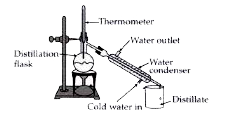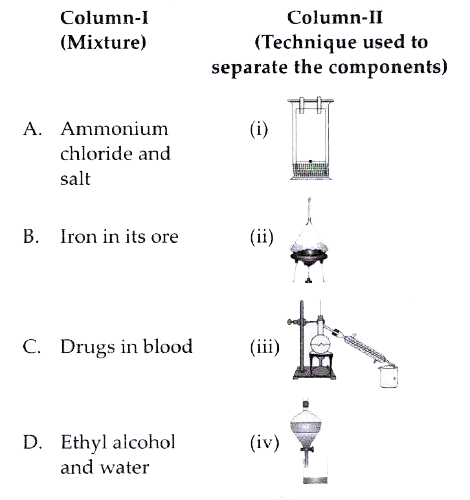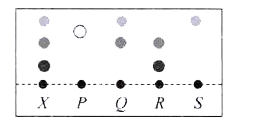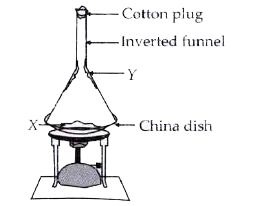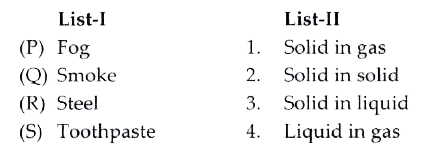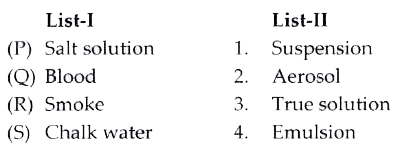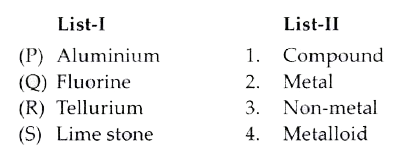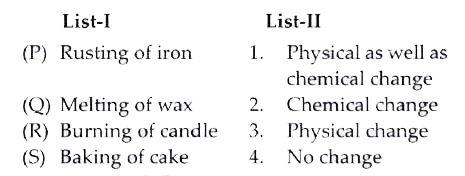EXERCISE (MULTIPLE CHOICE QUESTIONS-LEVEL-1) from MTG IIT JEE FOUNDATION IS MATTER AROUND US PURE ? for Class 9
| Class 9 | CHEMISTRY |
| Chapter | IS MATTER AROUND US PURE ? |
| MTG IIT JEE FOUNDATION | EXERCISE (MULTIPLE CHOICE QUESTIONS-LEVEL-1) |
| Medium | English |
| Academic Year | 2023-2024 |
Question 33
Water was taken in four beakers labelled as I to IV. To these beakers, the following substances were added. Beaker (I) - Common salt Beaker (II) - Alum Beaker (III) - Potassium nitrate Beaker (IV)- A few drops of barium chloride and a few drops of dilute H2SO4. After sometime, the contents of the beakers were filtered. The contents of which beaker will leave residue on the filter paper?View SolutionQuestion 39
Nandita has a substance Y which boils at 388 K and is immiscible with water. Y does not react with water. Which of the following separation methods will Nandita adopt to separate Y from a mixture containing another substance Z which boils at 278 K? (Both Y and Z are miscible).View SolutionQuestion 40
Two substances, A and B were made to react to form a third substance, A2B according to the following reaction : 2A+B→A2B. Which of the following statements concerning this reaction are incorrect? (i) The product A2B shows the properties of substances A and B. (ii) The product will always have a fixed composition (iii) The product so formed cannot be classified as a compound. (iv) The product so formed is an element. View SolutionQuestion 42
Seema told Rohan that water is a compound, not an element and to justify it, she gave the following reasons : I. Heat and light are given out during its formation from its constituent elements. II. It contains hydrogen and oxygen in the ratio of 1:8 by mass. III. Its boiling point is 373 K under one atmospheric pressure. The correct reasons are View SolutionQuestion 45
There is a mixture of three solid compounds A, B and C. Out of these compounds A and Care soluble in water and compound C is sublimable also. In what sequence the following techniques can be used for their effective separation? I. Filtration II. Sublimation III. Crystallisation from water extract IV. Dissolution in water View SolutionQuestion 66
Crystallisation is a process that separates a pure solid in the form of its crystals from a solution. A solid can also be separated from its solution by evaporation. However crystallisation technique is better than simple evaporation technique. We can get an impure sample of a solid even after evaporation. Some solids decomposes or some may get charred on heating to dryness during evaporation.
In which of the following processes, crystallisation is used. View SolutionQuestion 67
Crystallisation is a process that separates a pure solid in the form of its crystals from a solution. A solid can also be separated from its solution by evaporation. However crystallisation technique is better than simple evaporation technique. We can get an impure sample of a solid even after evaporation. Some solids decomposes or some may get charred on heating to dryness during evaporation.
Crystallisation is a better process than evaporation becauseView SolutionQuestion 68
Crystallisation is a process that separates a pure solid in the form of its crystals from a solution. A solid can also be separated from its solution by evaporation. However crystallisation technique is better than simple evaporation technique. We can get an impure sample of a solid even after evaporation. Some solids decomposes or some may get charred on heating to dryness during evaporation.
What type of mixtures are separated by crystallisation? View SolutionQuestion 69
Pure substances can be elements or compounds. An element is a form of matter which cannot be broken down by chemical reactions into simpler substances. A compound is a substance composed of two or more different types of elements, chemically combined in a fixed proportion. Properties of a compound are different from its constituent elements, whereas a mixture shows the properties of its constituting elements or compounds
Which of the following is not a pure substance?View SolutionQuestion 70
Pure substances can be elements or compounds. An element is a form of matter which cannot be broken down by chemical reactions into simpler substances. A compound is a substance composed of two or more different types of elements, chemically combined in a fixed proportion. Properties of a compound are different from its constituent elements, whereas a mixture shows the properties of its constituting elements or compounds
The substance formed by mixing, crushing and heating iron filings and sulphur powder is View SolutionQuestion 71
Pure substances can be elements or compounds. An element is a form of matter which cannot be broken down by chemical reactions into simpler substances. A compound is a substance composed of two or more different types of elements, chemically combined in a fixed proportion. Properties of a compound are different from its constituent elements, whereas a mixture shows the properties of its constituting elements or compounds
Name the element which becomes liquid at a temperature slightly above the room temperature.View Solution
All Exercises from MTG IIT JEE FOUNDATION Class 9 CHEMISTRY IS MATTER AROUND US PURE ?
- NCERT SECTION
- EXERCISE (ASSERTION & REASON TYPE)
- EXERCISE (COMPREHENSION TYPE)
- EXERCISE (INTEGER / NUMERICAL VALUE TYPE )
- EXERCISE (LONG ANSWER TYPE )
- EXERCISE (MATCH THE FOLLOWING)
- EXERCISE (MULTIPLE CHOICE QUESTIONS-LEVEL-1)
- EXERCISE (MULTIPLE CHOICE QUESTIONS-LEVEL-2)
- EXERCISE (SHORT ANSWER TYPE )
- EXERCISE (SUBJECTIVE PROBLEMS -VERY SHORT ANSWER TYPE )
- OLYMPIAD/ HOTS CORNER
- ILLUSTRATIONS
- SOLVED EXAMPLES

